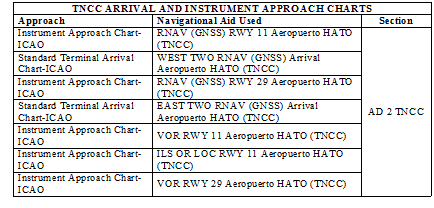The holding, arrival, approach and departure procedures in use throughout the Curaçao FIR are developed in accordance with the criteria contained in ICAO DOC 8168-OPS/611: Procedures for Air Navigation Services - Operations (PANS-OPS).
To ensure conformity with associated procedures, this section should be read in conjunction with section TNCC AD 2.22 FLIGHT PEOCEDURES paragraph 2.18 and 2.19
An aircraft approaching an aerodrome under IFR for the purpose of making a landing shall conform to the holding, arrival and instrument approach procedures for the radio navigational aid employed as prescribed in the appropriate Instrument Approach / Arrival charts: See Table below.

Note: Pilots will be expected to know the correct holding, approach and departure procedures.
1.5.2 Arriving flights
Pilots making instrument approaches to HATO Airport should refer to the procedures in the chart shown in table TNCC arrival and instrument approach Charts
The execution of an instrument approach is aided by HATO Tower providing monitoring service or when flight crew has the runway visual, whichever is earlier.
Category I ILS approach is only available for RWY 11at the HATO airport. Pilots making Category I ILS approaches to HATO Curaçao International Airport should refer to the procedures described in AD 2 TNCC-47 53 chart .
An IFR flight operating into HATO Airport may be cleared for a visual approach subject to
· The pilot has the aerodrome in sight and can conduct his approach with visual reference to terrain;
· The flight will not cause delay to other traffic;
· VMC Condition exists at HATO Airport:
o When below 3,000 ft. or 1,000 ft. above terrain, whichever is higher:
· Clear of cloud and in sight of the surface;
o The cloud ceiling at the aerodrome is 4,000ft or more for landing on RWY 11 and RWY 29
o Visibility at the aerodrome is 5km or more.
Notwithstanding paragraph 2.3, if the pilot reports that he has the aerodrome in sight and can conduct his approach with visual reference to terrain, the flight may be cleared for a visual approach.
Pilots may expect radar vectoring for separation and sequencing with other traffic prior to be cleared for a visual approach when under control of RADAR approach.
RADAR approach operational hours are between 17:00 - 23:00 UTC
1.5.3 Departing flights
3.1 IFR flights departing from Hato Curaçao International Airport will receive initial ATC clearance from HATO tower. The clearance limit will normally be the aerodrome of destination. Detailed instructions will be issued with regard to routes, turns, etc. after take off unless SID Procedures are in force, for the RWY in use.
3.2 The instrument departure procedures are laid down in standard instrument departures (SIDs) (SIDs are published for RWY 11 and 29 - Charts AD 2 TNCC-21 FOR RWY 11 and AD 2 TNCC - 25 RWY 29). SIDs are designated in accordance with ICAO Annex 11.
3.3 Instructions containing deviations from the standard instrument departure may be added to the en-route or take-off clearance. These instructions may comprise an opposite turn after take-off, maintaining a specified heading or temporary altitude restrictions; these additional instructions amend the relevant part of the SID only.
Note: if not able to comply with the crossing conditions prescribed in the SID’s inform Hato Tower.